It was by chance we discovered this gem of the Dolomites when planning a visit to the Messner Mountain Museum. Situated on the same plateau, it seemed the perfect museum for Super Alpine - mountains and photography, and we were proved right. The cable car from Bruneck takes you right past the Lumen building to the summit of the Kronplatz at 2275 metres in altitude. Could there be a more ideal setting for the museum? Exiting the cable car, it's a short walk to the entrance of the building that sits on the edge of the plateau.
The museum has a restaurant that overhangs the mountain and is the perfect place to enjoy a coffee before or after touring the exhibition. We couldn't think of a more perfect combination. At the reception is a small collection of books - we picked up the Lumen book of course. Our tourist tax even paid for the entrance because we were staying locally.
The museum spans four floors and it's best to start at the top with the history of mountain photography. The first two floors have remarkable images and actual cameras that were hauled to the tops of mountains. It's difficult to imagine carrying all this equipment to the top of a mountain.
The beauty of the museum is it does not focus just on historical work and styles that are popular on Instagram today. Instead, Lumen shows historical pictures and contemporary art side by side and even touches on tourism, politics and spirituality.
The 'Shutter' is particularly impressive - a large open shutter with a view of the mountains outside which then closes to show a projected film that poignantly demonstrates the damage we are doing to the mountains. Art from the 'Red Bull Illume' brings us right up to date before entering the Room of Mirrors, a trippy sensation partially illustrated in our video.
As well as these permanent exhibitions, there is a series of temporary ones like Ester Vonplon's Blazing White - snow and ice as seen through the lens of analog photography. The inclusion of a cover that was used on the glacier to stop it from melting is affecting and closed out the exhibition for us.
The location of the museum is not that easy to get to - it's 900 miles of road, a sea crossing and a cable car from where we live but I would say it was almost worth the trip alone. It is fantastic that mountain photography has a home like this and one that does not push the narrative of social media, instead choosing to support art that would not find a home elsewhere.
The tour from the top across the summits leading, literally, "down to earth" lets visitors experience the mountain and pay respect to its majesty.Richard Piock




